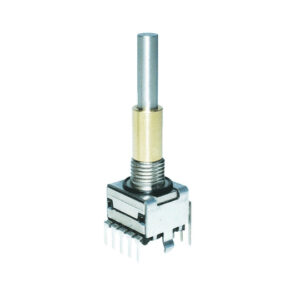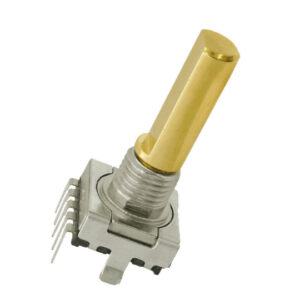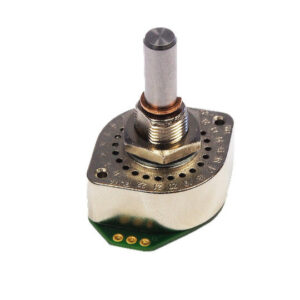Rotary Encoders
Rotary Encoders are a type of switch which convert the rotational movement of the shaft into an analog or digital signal. This is done by converting an input voltage into a different output voltage (analog) or a digital signal depending on the position of the shaft. Rotary encoders are available with absolute or incremental outputs. Absolute encoders relay the current position of the shaft, in the most basic form this could be an on-off switch. Whereas incremental encoders provide information on the motion of the shaft, this could be used for volume control in a car where rotating the switch one way will increase the volume, even if it goes beyond 360 degrees. We also offer a wide variety of knobs for rotary encoders which can be found here.
View Frequently Asked Questions about Rotary EncodersType E37 Series
The Type E37 Series from Elma is a high-performance mechanical dual incremental encoder. Based on the Type E33 series and including all the benefits, the Type E37 offers dual encoders in a housing only 4.2mm deeper....
View ProductType E33 Series
The Type E33 Series from Elma is a high-performance miniature mechanical incremental encoder. Designed with Elma’s exclusive Swiss Click Indexing System which ensures consistent rotational torque over the encoder entire lifetime....
View ProductX4
The X4 series of Hall-Effect rotary switches from Elma are a new style of multi rotary switch which can be used as an incremental encoder or an absolute coded switch with outputs choices of Analog, PWM, Parallel and UART....
View ProductFrequently Asked Questions about Rotary Encoders
An encoder works by changing a mechanical input, rotating the encoders actuator (clockwise or anticlockwise), into an electrical output which can be read by a computer or PLC. There are many different types of encoders, ie. Incremental, Absolute, Magnetic, Optical and Laser, however Live Electronics mainly sell Incremental and Absolute versions. An Incremental encoder reads the displacement between two output signals, this is called the square wave frequency. This works through the use of two output signal contacts which are spaced in a particular way. These then make contact with evenly spaced contacts attached to the actuator. By reading these on-off signals (in digital 0,1) the computer system knows the direction and speed of the rotation. An Absolute encoder has multiple detector contacts and disc contacts in unique tracks. This produces a Gray code output, this unique code can then be read by the computer system to determine the exact position of the actuator.
Rotary encoders are used in many applications for sensing the position of the actuator. This makes rotary encoders ideal for applications such as CNC machines, robotics, train automation, CT and MRI machines, commercial white goods, audio and video equipment, aviation and automotive.
An absolute rotary encoder is used to determine the exact position on its actuator, this means it can work up to 360° of rotation. In its most basic format this could be used as a simple on-off rotary switch, in a more advanced system it could be used to mark the exact position of a CNC machine bit.



